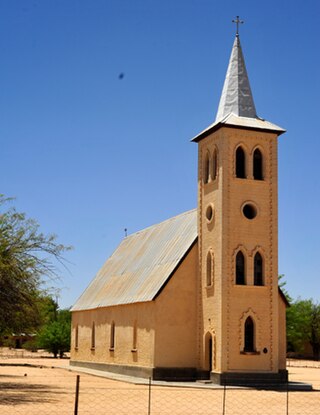Related Research Articles

Namibia uses regions as its first-level subnational administrative divisions. Since 2013, it has 14 regions which in turn are subdivided into 121 constituencies.
Postal codes were introduced in South Africa on 8 October 1973, with the introduction of automated sorting.

The South West Africa Territorial Force (SWATF) was an auxiliary arm of the South African Defence Force (SADF) and comprised the armed forces of South West Africa from 1977 to 1989. It emerged as a product of South Africa's political control of the territory which was granted to the former as a League of Nations mandate following World War I.

Otjimbingwe is a settlement in the Erongo Region of central Namibia. Otjimbingwe has approximately 8,000 inhabitants and belongs to the Karibib electoral constituency.
The Trans-Kalahari Corridor is a paved highway corridor that provides a direct route from the port of Walvis Bay and Windhoek in central Namibia, through Botswana, to Pretoria in Gauteng province in South Africa. It initially cost approximately 850 million Namibian dollars and was officially opened in 1998.

TransNamib Holdings Limited, commonly referred to as TransNamib, is a state-owned railway company in Namibia. Organised as a holding company, it provides both rail and road freight services, as well as passenger rail services. Its headquarters are in the country’s capital Windhoek.

The Namibia Premier League (NPL) was the highest level of domestic association football in Namibia until it was disbanded following the 2018-19 season. The league was established in 1990 and was trimmed to 12 teams from the traditional 16 in 2005. It was disbanded in 2020 after ongoing problems with the Namibia Football Association, which finally ended their relationship. The NFA founded the Namibia Football Premier League to replace it. The new league kicked off with the 2022-2023 season with African Stars against Unam at the Hage Geingob Rugby Stadium.
Articles related to Namibia include:

Vehicle registration plates of Namibia are yellow fluorescent metal plates with imprints in black. The standard version is uniform throughout the country, and carries one of the following forms:

The B1 is a national highway of Namibia, and is the country's longest and most significant road, running the length of the country from south to north. It connects Noordoewer in the south on the South African border with Oshikango in the north on the Angolan border via Namibia's capital city Windhoek.

Okahandja railway station is a railway station serving the town of Okahandja in Namibia. It is part of the TransNamib Railway.

Kranzberg railway station is a railway station in Namibia between the towns of Karibib and Usakos. It is part of the TransNamib Railway. At Kranzberg, the railway line from Windhoek splits; one line continues westwards to Swakopmund and Walvis Bay, the other one continues north-eastwards towards Omaruru and Tsumeb.
Hermann Heinrich Vedder was a German missionary, linguist, ethnologist and historian. Originally a silk weaver, he received missionary training by the Rhenish Missionary Society in Barmen between 1894 and 1903, whereafter he was sent to German South West Africa in 1905 and worked as a missionary and teacher trainer until his retirement, first for the black workers and prisoners-of-war in Swakopmund, then at the small mission station Gaub in the Otavi Mountains, and from 1922 onwards in Okahandja, where he taught at the Augustineum school.

Namibia, formerly known as South West Africa and German South West Africa, has a long history of postal services, starting in 1814 with postal runners delivering messages among mission stations. The first stamps were printed during the German colonial period. Currently NamPost is responsible for running postal services, managing 135 postal offices in the country.

Postage stamps were issued in the South African-administered colony of South West Africa from 1914 to 1989.

The rail service in Namibia is provided by TransNamib. The Namibian rail network consists of 2,687 km of tracks (2017).

Squatting in Namibia is the occupation of unused land or derelict buildings without the permission of the owner. European settlers arrived in the nineteenth century and acquired land, leaving only 38 per cent of land in indigenous hands by 1902. This led to squatting and the Herero Wars, which ended with the Herero and Namaqua genocide. After Namibian independence in 1990, squatting increased as people migrated to the cities and land reform became a goal for those who had participated in the liberation struggle. By 2020, 401,748 people were living in 113 informal settlements across the country. Squatting continues to be regulated by the Squatters Proclamation of 1985; a challenge to this law was dismissed by the High Court in 2023.
References
- ↑ Namibian Post Code. Nampost. Retrieved on 9 January 2019.
- ↑ The comprehensive handbook of the postmarks of German South West Africa, South West Africa, Namibia, Ralph F. Putzel, R.F. Putzel, 1991, page 173
- ↑ South African Panorama – Volume 22, South African Information Service, 1977, page 9
- ↑ South West Africa & Walvis Bay – Suidwes-Afrika & Walvisbaai, Department of Posts and Telecommunications, 1978, page iv
- ↑ SWA Annual/SWA Jaarboek/SWA Jahrbuch, South West Africa Publications, Limited, 1977, page 80
- ↑ The South African Shipping News and Fishing Industry Review, Volume 39, Thomson Newspapers, 1984, page 35
- ↑ Africa's Gem, Department of Economic Affairs, South West Africa/Namibia, 1981, page 3
- ↑ SWA Annual, South West Africa Publications, Limited, 1986, page 44
- ↑ Monitoring in South African grasslands, M. T. Mentis, National Programme for Environmental Sciences (South Africa). Committee for Terrestrial Ecosystems, CSIR Foundation for Research Development, Council for Scientific and Industrial Research, 1984, page 47
- ↑ Walvis Bay: exclave no more, Ieuan Griffiths, Geography, Vol. 79, No. 4 (October 1994), page 354
